Themed collection Electrochemistry at nano-interfaces

List of participants
Poster list
Nanoscale electrochemical kinetics & dynamics: the challenges and opportunities of single-entity measurements
The stochastic nature of very fast single-entity events challenges current electrochemical methods and modern electronics, as illustrated using recent experiments from the authors’ laboratory.

Faraday Discuss., 2018,210, 9-28
https://doi.org/10.1039/C8FD00134K
Science and technology of electrochemistry at nano-interfaces: concluding remarks
The Faraday Discussion on electrochemistry at nano-interfaces presented a platform for an incredibly diverse array of advances in electrochemical nanoscience and nanotechnology.

Faraday Discuss., 2018,210, 481-493
https://doi.org/10.1039/C8FD00128F
Real-time in situ dynamic sub-surface imaging of multi-component electrodeposited films using event mode neutron reflectivity
We investigate the deposition, evolution and dissolution of single and two-component metal layers on Au substrates immersed in the deep eutectic solvent Ethaline.
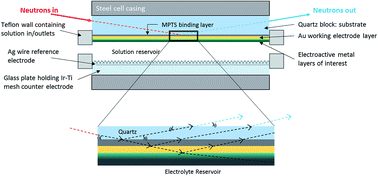
Faraday Discuss., 2018,210, 429-449
https://doi.org/10.1039/C8FD00084K
Electrochemistry at a single nanoparticle: from bipolar regime to tunnelling
This paper is concerned with long-distance interactions between an unbiased metal nanoparticle (NP) and a nanoelectrode employed as a tip in the scanning electrochemical microscope (SECM).
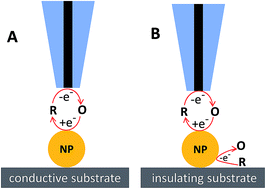
Faraday Discuss., 2018,210, 173-188
https://doi.org/10.1039/C8FD00041G
The promise of antireflective gold electrodes for optically monitoring the electro-deposition of single silver nanoparticles
Combined to electrochemical actuation, it allows the dynamic in situ visualization of the electrochemical growth and dissolution of individual Ag nanoparticles.
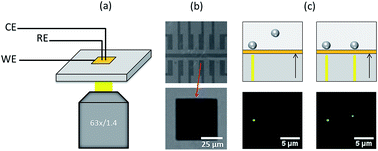
Faraday Discuss., 2018,210, 381-395
https://doi.org/10.1039/C8FD00037A
Real-time determination of aggregated alpha-synuclein induced membrane disruption at neuroblastoma cells using scanning ion conductance microscopy
Alpha-synuclein aggregates induced cell membrane disruption was observed in real time with scanning ion conductance microscopy.
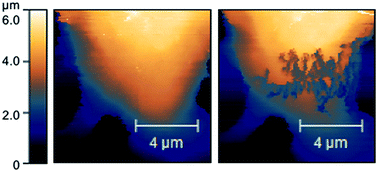
Faraday Discuss., 2018,210, 131-143
https://doi.org/10.1039/C8FD00059J
Probing ion current in solid-electrolytes at the meso- and nanoscale
The ionic conductivity of silica ionogel based solid electrolyte on meso and nanoscales is measured.
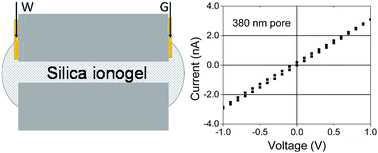
Faraday Discuss., 2018,210, 55-67
https://doi.org/10.1039/C8FD00071A
A study of dynamic nanoscale corrosion initiation events using HS-AFM
Using HS-AFM measurements it was possible to calculate, and subsequently model, the volumes of metal reacting with respect to time, and so the current densities and ionic fluxes at work. In this manner, the local electrochemistry at nanoscale reaction sites may be reconstructed.
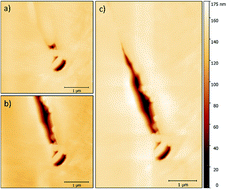
Faraday Discuss., 2018,210, 409-428
https://doi.org/10.1039/C8FD00017D
Functionalised microscale nanoband edge electrode (MNEE) arrays: the systematic quantitative study of hydrogels grown on nanoelectrode biosensor arrays for enhanced sensing in biological media
We demonstrate a hydrogel-coated nanoelectrode array biosensor that is resistant to biofouling.

Faraday Discuss., 2018,210, 201-217
https://doi.org/10.1039/C8FD00063H
Shape-controlled electrodeposition of single Pt nanocrystals onto carbon nanoelectrodes
In this paper, we report the electrosynthesis and characterization of individual, shape-controlled Pt nanocrystals electrodeposited on carbon nanoelectrodes.
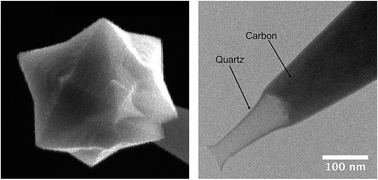
Faraday Discuss., 2018,210, 267-280
https://doi.org/10.1039/C8FD00018B
Hydrogen adsorption on nano-structured platinum electrodes
We present evidence that the “third hydrogen peak” involves surface-adsorbed hydrogen on a locally “reconstructed” (110)-type surface site.
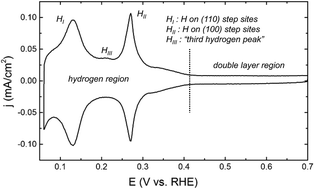
Faraday Discuss., 2018,210, 301-315
https://doi.org/10.1039/C8FD00062J
Illuminating nanostructured gold electrode: surface plasmons or electron ejection?
We used a surface-plasmon-active gold-mushroom-array as a working electrode and observed enhanced faradaic current from ferrocenemethanol following illumination with a xenon lamp. The photoelectric current behaved differently in the presence and absence of oxygen in the solution.
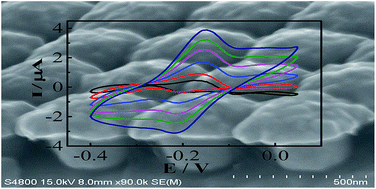
Faraday Discuss., 2018,210, 281-287
https://doi.org/10.1039/C8FD00012C
Biomimetic ion channels formation by emulsion based on chemically modified cyclodextrin nanotubes
We present short cyclodextrin nanotubes that form ion channels in lipid bilayers.
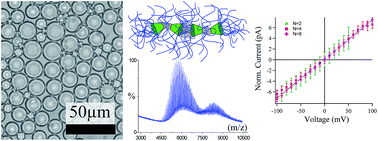
Faraday Discuss., 2018,210, 41-54
https://doi.org/10.1039/C8FD00030A
Nanoscale electrochemical movies and synchronous topographical mapping of electrocatalytic materials
Nanopipette imaging probes (ca. 30 nm) are used to map the activity/topography of nanostructured electrocatalysts directly, revealing active sites unambiguously.
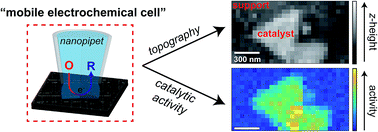
Faraday Discuss., 2018,210, 365-379
https://doi.org/10.1039/C8FD00028J
Ligament size-dependent electrocatalytic activity of nanoporous Ag network for CO2 reduction
Nanoporous Ag (ligament size: 21 nm) exhibits superior CO selectivity and activity, confirming strong ligament size effects on CO2 reduction.
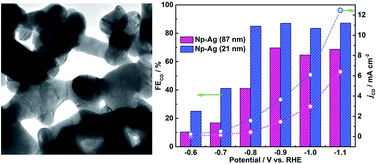
Faraday Discuss., 2018,210, 289-299
https://doi.org/10.1039/C8FD00056E
Quantifying photothermal heating at plasmonic nanoparticles by scanning electrochemical microscopy
Here we present a methodology for probing the surface temperature at a plasmonic nanoparticle substrate using scanning electrochemical microscopy.
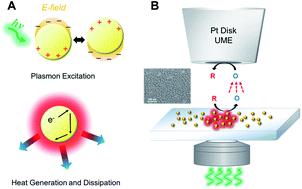
Faraday Discuss., 2018,210, 29-39
https://doi.org/10.1039/C8FD00057C
Electrochemical quantification of transmitter concentration in single nanoscale vesicles isolated from PC12 cells
Vesicle impact electrochemical cytometry shows vesicular catecholamine concentration is relatively constant and independent of the vesicular size.
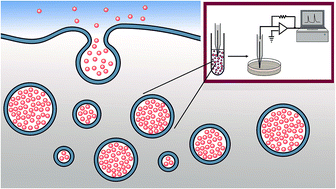
Faraday Discuss., 2018,210, 353-364
https://doi.org/10.1039/C8FD00020D
Measuring a frequency spectrum for single-molecule interactions with a confined nanopore
The time-domain nanopore signal is preciously converted into energy–frequency–time spectra with high frequency resolution and high time resolution using the Hilbert–Huang transform for revealing the detail behaviours of single-molecule weak interactions.
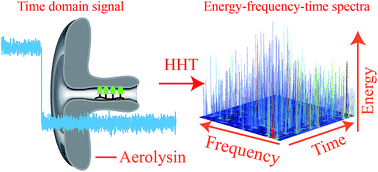
Faraday Discuss., 2018,210, 87-99
https://doi.org/10.1039/C8FD00023A
Single Ag nanoparticle collisions within a dual-electrode micro-gap cell
An adjustable width (between 600 nm and 20 μm) gap between two Au microelectrodes is used to probe the electrodissolution dynamics of single Ag nanoparticles.
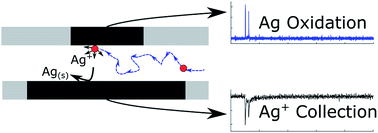
Faraday Discuss., 2018,210, 189-200
https://doi.org/10.1039/C8FD00014J
Unexpected ionic transport behavior in hydrophobic and uncharged conical nanopores
We investigated ionic transport behavior in the case of uncharged conical nanopores. We observed unexpected ionic transport behaviour, which is attributed to a predominant effect of slippage due to water organization at the solid/liquid interface.
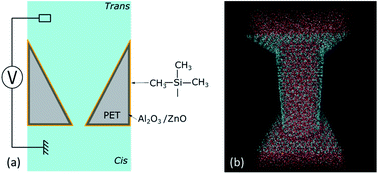
Faraday Discuss., 2018,210, 69-85
https://doi.org/10.1039/C8FD00008E
Investigation of modified nanopore arrays using FIB/SEM tomography
FIB/SEM tomography and energy dispersive X-ray (EDX) spectroscopy are employed to study the interface between two immiscible electrolyte solutions at nanopore arrays, which were electrochemically modified by silica.
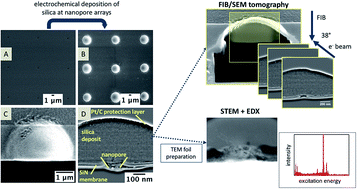
Faraday Discuss., 2018,210, 113-130
https://doi.org/10.1039/C8FD00019K
A Pb2+ ionic gate with enhanced stability and improved sensitivity based on a 4′-aminobenzo-18-crown-6 modified funnel-shaped nanochannel
An ionic gate for sensing Pb2+ based on an emerging advanced funnel-shaped nanochannel system is reported, with enhanced stability and improved sensitivity.
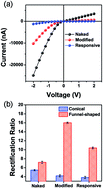
Faraday Discuss., 2018,210, 101-111
https://doi.org/10.1039/C8FD00025E
Evaluation of the intrinsic catalytic activity of nanoparticles without prior knowledge of the mass loading
We propose a method enabling the evaluation of intrinsic catalytic activity of nanoparticles based on the diffusion-limited steady-state current.

Faraday Discuss., 2018,210, 317-332
https://doi.org/10.1039/C8FD00029H
Charge transport at a molecular GaAs nanoscale junction
The use of semiconducting electrodes in molecular junctions is an elegant way to impart new properties to nanodevices. Here we report metal-molecule(s)–metal Schottky photodiodes whose behaviour can be tuned by appropriate choice of molecule and doping density, giving further insights into the molecule–semiconductor interface.
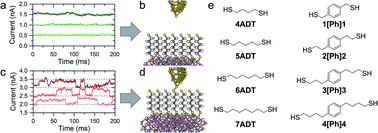
Faraday Discuss., 2018,210, 397-408
https://doi.org/10.1039/C8FD00016F
Effects of the dipolar double layer on elemental electrode processes at micro- and macro-interfaces
The present work reveals the role of nano-interfaces on domain size and the thickness in the context of the relationship between double layer impedances and redox reactions.
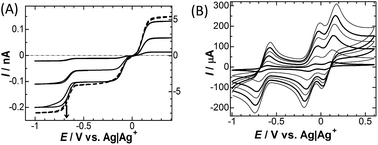
Faraday Discuss., 2018,210, 219-234
https://doi.org/10.1039/C7FD00212B
Processes at nanoelectrodes: general discussion
Faraday Discuss., 2018,210, 235-265
https://doi.org/10.1039/C8FD90024H
Processes at nanopores and bio-nanointerfaces: general discussion
Faraday Discuss., 2018,210, 145-171
https://doi.org/10.1039/C8FD90023J
Dynamics of nanointerfaces: general discussion
Faraday Discuss., 2018,210, 451-479
https://doi.org/10.1039/C8FD90026D
Energy conversion at nanointerfaces: general discussion
Faraday Discuss., 2018,210, 333-351
https://doi.org/10.1039/C8FD90025F
About this collection
We are delighted to share with you a selection of the papers which will be presented at our Faraday Discussion on Electrochemistry at Nano-interfaces taking place in Bath, UK in June 2018. More information about the event may be found here: http://rsc.li/nanointerfacesfd2018. Additional articles will be added to the collection as they are published. The final versions of all the articles presented and a record of the live discussions will be published after the event.
The active nano-interface is important in electrochemistry because it constitutes the place where electron/ion transfer reactions occur coupled to extremely fast mass transport and under exquisite control of local conditions. Electrochemistry at nano-interfaces poses major fundamental and conceptual challenges in physical electrochemistry, while also being central to the emergence of real applications. Nano-interfaces are a major theme in energy transforming technologies (
e.g.batteries, fuel cells, solar cells), electrochemical biosensors, diagnostic platforms, in bio-electrochemistry, and in nano-electrochemical mapping/imaging techniques. All of these areas face common challenges linked to the nano-interface concept.